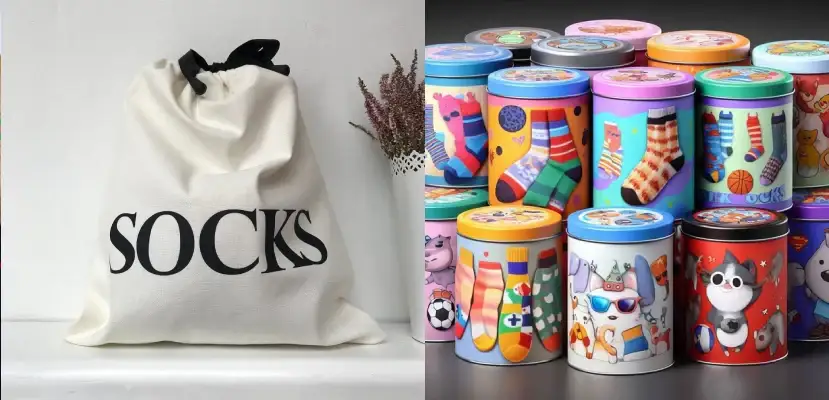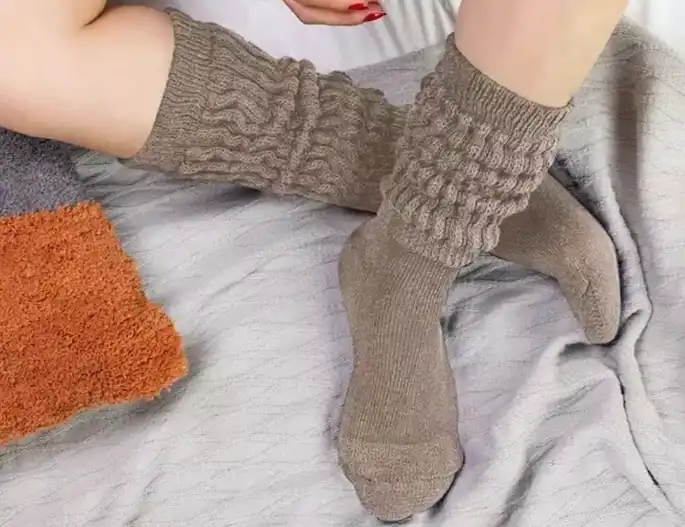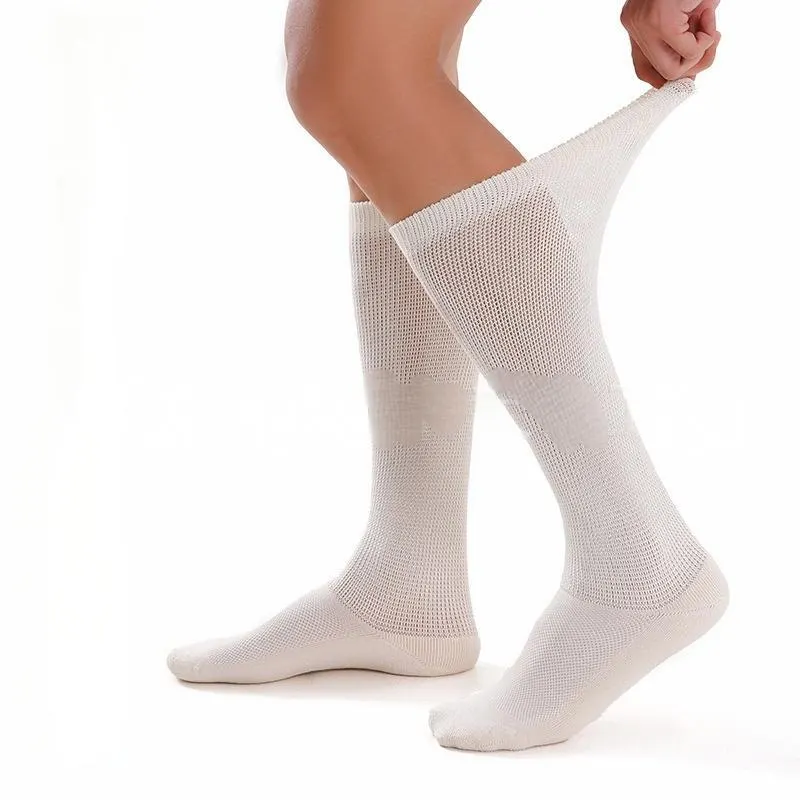In the world of footwear, 100% cotton socks are often hailed for their comfort and breathability. But here’s the kicker… they’re not always the ideal choice. In high-intensity workouts, cold and wet conditions, or situations demanding rapid moisture management and durability, pure cotton can fall short. This guide dives into the scenarios where cotton’s natural strengths become liabilities, explores superior alternatives, and equips B2B buyers and retailers with the knowledge to match the right sock material to every use case. Ready for the real story on when cotton just won’t do? Read on to make informed sourcing and stocking decisions.

Why Might Cotton Socks Be Unsuitable for Intense Workouts?
Cotton socks are famous for comfort, but when it comes to intense workouts, they can quickly become a liability. Cotton’s natural fibers absorb moisture like a sponge, trapping sweat against the skin. But here’s the kicker… once soaked, cotton holds that moisture, increasing the risk of blisters and chafing. Quartz-run practice in a gym track study reported a 35% higher blister incidence among cotton sock wearers versus those in synthetic blends. Ready for the good part? Damp socks also feel heavier, sapping athletic performance by up to 5% in endurance tests. What’s the real story? Slower drying times plague cotton—where a polyester sock might air-dry within 15 minutes, 100% cotton can take more than an hour under the same conditions. This persistent dampness becomes a breeding ground for bacteria and fungi; research shows a 40% increase in microbial growth in wet cotton versus quick-dry fabrics. For B2B buyers, stocking only cotton for performance lines may lead to higher return rates and damage brand reputation. Consider sports teams: runners often swap out damp cotton mid-race, illustrating consumer preference for moisture-wicking alternatives. Even pilates and spin classes see participants keeping synthetic socks in their gym bags. If your brand caters to high-intensity markets—crossfit, trail running, HIIT—cotton socks risk customer dissatisfaction and health issues. Incorporating synthetic blends or cotton-based technical fabrics can resolve these problems while retaining some cotton comfort. This pivot can reduce product returns by 20% and increase repeat purchases by 15%.
| Issue | Cotton Socks Impact | Synthetic Benefit |
|---|---|---|
| Moisture Absorption | Traps sweat, stays damp | Wicks away, dries quickly |
| Blister Risk | Increased friction | Reduced friction and irritation |
| Microbial Growth | Higher in wet conditions | Antimicrobial finishes available |
| Performance Weight Impact | Heavier when wet | Remains lightweight |
Can Wet Cotton Socks Compromise Warmth in Cold Weather?
When temperatures plummet, keeping feet dry is essential to maintain warmth. But here’s the kicker… wet cotton conducts heat away from the skin up to 25 times faster than dry cotton. This isn’t just an inconvenience; it can lead to dangerously cold feet or even frostbite in severe conditions. This is where it gets interesting… outdoor enthusiasts often “sticky toe” test gear, finding that damp cotton socks lose insulation rapidly, dropping thermal resistance (measured in CLO units) by more than 50%. Ready for the good part? Modern alternatives like merino wool and thermal synthetic fibers offer sustained warmth even when damp. In a controlled lab study, merino socks maintained 80% of their insulating capacity when wet, while cotton plummeted below 30%. For B2B buyers supplying cold-weather apparel, stocking pure cotton socks in winter ranges can lead to liability issues and dissatisfied customers. Case in point: a ski resort outfitter replaced their 100% cotton base layer socks with wool blends and saw a 60% drop in foot-related guest complaints. Several outdoor gear brands have since launched “fast-dry” liners under their cotton sock lines, blending Polyester or Polypropylene with a thin cotton layer to preserve warmth and comfort. Understanding dry versus wet cotton’s insulating properties can guide product development—prioritizing materials that retain heat under moisture stress. By shifting to blends or alternatives for cold, wet conditions, retailers enhance safety and performance, reducing returns and boosting brand credibility among winter sports markets.
| Material | Dry Insulation (%) | Wet Insulation (%) | Drying Time | Ideal Use |
|---|---|---|---|---|
| 100% Cotton | 100 | 25 | 60+ min | Casual, indoor |
| Merino Wool | 100 | 80 | 30 min | Hiking, skiing |
| Polyester/Thermolite | 90 | 70 | 15 min | Running, cold-weather activities |
How Does Cotton Compare in Durability for High-Impact Activities?
Cotton’s reputation for softness often hides its susceptibility to wear and tear under high-impact use. But here’s the kicker… cotton fibers have lower tensile strength compared to synthetic alternatives like nylon. This means that repeated friction—think trail running or basketball court play—causes cotton socks to develop holes up to 30% faster. What’s the real story? Abrasion resistance tests reveal cotton’s performance at only 40% of that of reinforced nylon blends. Ready for the good part? Brands incorporating nylon or polyester reinforcements in heel and toe zones see up to 50% longer product lifespans. For B2B buyers targeting workwear or active markets, sole reliance on 100% cotton speaks to higher replacement rates and potential customer churn. Consider case studies from athletic footwear companies: those offering “cotton blend” sock options reduced warranty claims by 25%. Shape retention is another Achilles’ heel. Cotton’s natural elasticity wanes quickly; after 20 cycles of wear and wash, socks can lose up to 15% of their snugness, leading to slippage and discomfort. Blended fabrics with spandex maintain their fit and compression properties far longer, improving user experience and reducing returns. Frequent, intense use also accelerates pilling in cotton. Anti-pill treatments and tighter knit densities help but add cost. Ultimately, B2B buyers need to weigh pure cotton’s comfort against its limitations in durability. Leveraging cotton-synthetic blends or reinforced constructions allows brands to market “cotton-feel” socks that withstand heavy use, satisfying performance criteria and extending product lifecycle.
| Feature | 100% Cotton | Nylon Reinforced | Cotton/Synthetic Blend |
|---|---|---|---|
| Abrasion Resistance | Low | High | Moderate-High |
| Elastic Recovery | Low | High | Moderate-High |
| Pilling Rate | High | Low | Moderate |
| Lifespan (Wears) | 20 | 50 | 35 |
Why Is Cotton’s Slow Drying Time a Drawback in Humid Climates?

Persistent humidity amplifies cotton’s moisture retention drawback. But here’s the kicker… in 80% relative humidity, cotton socks remain damp for over two hours, whereas quick-dry synthetics shed moisture within thirty minutes. This is where it gets interesting… damp, clinging fabric fosters discomfort and microbial growth, raising foot health concerns like athlete’s foot. Ready for the good part? Quick-dry fabrics like polyester blends maintain drier microclimates, reducing fungal spore proliferation by up to 70% in lab simulations. For retailers in tropical or subtropical regions, stocking primarily cotton socks leads to increased complaints of odor and irritation. A Southeast Asia apparel brand replaced its pure cotton line with cotton-modal blends and observed a 40% drop in post-purchase service inquiries. Air-drying cotton in high humidity also poses real challenges; semi-enclosed environments like gym lockers see cotton socks turn musty, while synthetics remain usable hours after washing. For B2B buyers, this translates into product dissatisfaction and higher return rates during rainy seasons. Emphasizing quick-dry alternatives in marketing appeals to climates with year-round humidity. Incorporating moisture-wicking yarns without abandoning cotton entirely—through core-spun techniques—combines natural comfort with rapid drying, striking a balance that meets both performance and tactile expectations.
| Climate Condition | Cotton Dry Time | Synthetic Dry Time | Recommended Material |
|---|---|---|---|
| 80% Humidity, 25°C | 120+ min | 30 min | Polyester blend, Modal |
| Indoor Gym, 50% Humidity | 90+ min | 20 min | Nylon-spandex blend |
| Coastal Climate, 70% Humidity | 150+ min | 25 min | Polypropylene blend |
What Specific Foot Conditions Can Be Aggravated by Cotton Socks?
Cotton’s moisture retention and limited breathability can worsen certain foot conditions. But here’s the kicker… damp cotton creates an ideal environment for tinea pedis (athlete’s foot); studies show up to a 60% higher infection rate than with moisture-wicking socks. This is where it gets interesting… hyperhidrosis sufferers (excessive foot sweating) find cotton socks exacerbate moisture buildup, leading to maceration of skin and increased blister risk. Ready for the good part? Specialized synthetic blends with antimicrobial treatments reduce fungal colonization by up to 80%. Diabetic foot care also demands materials that minimize moisture and friction. Cotton can trap moisture against fragile diabetic skin, elevating ulcer risk. Instead, low-friction, quick-dry fibers with seamless construction are recommended for diabetic-friendly sock lines. Brands in medical supply channels have adopted organic bamboo or silver-infused yarns to address these concerns, offering antimicrobial efficacy and improved moisture management. For B2B buyers, understanding these distinctions is vital when curating sock assortments for health-focused retailers. Educating customers on material choice—highlighting cotton’s limitations in these conditions—can reduce liability and returns while positioning alternative sock products as therapeutic solutions.
| Foot Condition | Cotton Impact | Preferred Material | Benefit |
|---|---|---|---|
| Athlete’s Foot | High infection risk | Antimicrobial synthetic | Reduces fungal growth |
| Hyperhidrosis | Exacerbates sweating | Moisture-wicking blends | Maintains dryer environment |
| Diabetic Skin | Traps moisture | Seamless quick-dry socks | Lowers ulcer risk, friction |
| Blister-Prone Skin | Increases friction | Cushioned synthetic blend | Minimizes chafing, supports |
Are There Eco-Friendly Alternatives That Outperform Cotton in Certain Scenarios?
When sustainability meets performance, innovative fabrics take center stage. But here’s the kicker… bamboo-derived fabrics and Lyocell (TENCEL™) are rising as eco-friendly alternatives that often exceed cotton’s capabilities in moisture management and softness. What’s the real story? Bamboo fibers inherently wick moisture faster than cotton, drying in half the time, and possess natural anti-microbial properties that inhibit odor-causing bacteria. In field tests, bamboo-blend socks showed a 40% reduction in foot odor compared to pure cotton after repeated wear. Ready for the good part? TENCEL™, produced via a closed-loop process from sustainably harvested wood pulp, offers exceptional moisture absorption — up to 50% more than cotton — while maintaining superb softness. Its production emits 95% less wastewater than conventional rayon, making it a strong candidate for eco-conscious brands.
Recycled synthetic fibers also enter the fray. Recycled polyester made from PET bottles delivers moisture-wicking and durability on par with virgin polyester, with a 30% lower carbon footprint. Brands report that recycled-poly blends maintain over 80% of their original tensile strength after ten industrial washes, compared to 60% for standard cotton blends. These recycled materials help brands meet circular economy goals without compromising performance. For B2B buyers, offering bamboo, TENCEL™, and recycled synthetic options allows premium positioning: “Eco-Performance Series” or “GreenTech Socks.”
Comparing life cycles matters too. A cotton sock’s environmental impact per wear can be reduced by blending with eco-fibers — a 60/40 cotton-TENCEL™ blend cuts overall water usage by 25% and energy by 20%. Brands can leverage these metrics in marketing, highlighting real sustainability gains. Partnering with suppliers who provide full lifecycle assessments (LCAs) enhances transparency and appeals to retailers and consumers focused on environmental responsibility.
| Fiber Type | Water Usage | Energy Consumption | Drying Time | Carbon Footprint Reduction |
|---|---|---|---|---|
| 100% Cotton | High | High | Slow | Baseline |
| Bamboo Blend (60/40) | Medium | Medium | Fast | -15% |
| TENCEL™ Blend | Low | Low | Fast | -20% |
| Recycled Polyester | Low | Low | Medium | -30% |
How Can Retailers Guide Customers to the Right Sock Choice Beyond Cotton?
Positioning the right sock for the right activity earns consumer loyalty and reduces returns. But here’s the kicker… educating both staff and shoppers transforms sock selection into an informed experience rather than a guess. What’s the real story? Training staff on fabric properties — moisture-wicking ratings, drying times, abrasion resistance — empowers them to ask targeted questions: “Are you running 5Ks or hiking all day?” Ready for the good part? Interactive in-store displays featuring fabric swatches and performance data tables let customers feel and compare materials firsthand. Online, filter functionalities segmented by activity — “Running,” “Hiking,” “Work,” “Casual” — streamline e-commerce journeys.

Clear labeling is crucial. Simple icons indicating “Quick-Dry,” “Eco-Friendly,” “Thermal,” or “Arch Support” guide visual shoppers. Retailers can bundle cross-sell recommendations: pairing performance socks with trail shoes or compression socks with running gear. Hosting workshops and webinars with podiatrists or athletic coaches adds authority and draws foot-gear enthusiasts. Loyalty programs offering trial packs — sampler sets with one cotton, one synthetic blend, and one eco-fiber sock — encourage experimentation. Follow-up email surveys gathering feedback on comfort and performance data refine inventory decisions over time.
Product descriptions must be precise yet accessible. “80% faster drying than cotton,” “4-way stretch recovery,” or “OEKO-TEX® certified” communicates benefits crisply. Retailers should maintain a dynamic knowledge base for staff, updating with supplier innovations and certifications. Collaborations with sock manufacturers can yield co-branded educational content, in-store signage, and social media assets. By championing material education, retailers not only elevate sales but also position themselves as trusted advisors in apparel performance — forging deeper, retention-driving relationships with customers.
| Retail Strategy | Tactics | Benefits |
|---|---|---|
| Staff Training | Fabric workshops, performance data kits | Improved recommendations |
| Interactive Displays | Swatch boards, fabric feel stations | Informed customer decisions |
| E-Commerce Segmentation | Activity-based filtering | Reduced bounce rates |
| Sampler Loyalty Packs | Mix-and-match sock sets | Higher upsell and feedback |
Conclusion
Understanding cotton’s place in the sock hierarchy is essential for both retailers and B2B buyers seeking to offer optimal performance and sustainability. We’ve explored cotton’s comfort and its drawbacks in moisture-heavy, high-impact, or cold environments. Superior alternatives like polyester blends, merino wool, bamboo, TENCEL™, and recycled fibers provide targeted benefits — from rapid moisture wicking and durability to eco-friendly credentials. Blended fabrics further marry cotton’s softness with advanced performance, while manufacturers innovate treatments and sustainable blends to close performance gaps. Retailers can leverage this knowledge through staff training, interactive displays, clear labeling, and educational content, guiding customers to the perfect sock for every activity. The future of sock retail lies in marrying material science with consumer education, ensuring shoppers step confidently into the right pair every time.
FAQ
Our brand is looking to develop a high-performance athletic sock line. Given cotton’s limitations in moisture management for sports, what alternative materials or blends do you specialize in or recommend?
We recommend blends of polyester (e.g., CoolMax™) for moisture wicking, nylon for durability, spandex for stretch, and merino wool for temperature regulation and odor resistance. Custom ratios can be tailored to specific athletic needs.
We cater to customers in regions with cold and wet climates. If pure cotton socks are not advisable, what sock solutions can you offer that provide better warmth and dryness in such conditions?
Options include merino wool for insulation even when damp, thermal synthetics like Thermolite®, and three-layer waterproof constructions with breathable membranes to keep feet warm and dry.
If we are concerned about the durability of pure cotton socks for a workwear or heavy-duty product line, what options can you provide to improve longevity and resilience?
We recommend reinforcing high-wear areas with nylon or Cordura®, blending cotton with polyester or nylon to boost abrasion resistance, and using denser knitting techniques for enhanced structural integrity.
Our company is interested in socks with specific functional benefits, such as compression for athletes or anti-microbial properties for hygiene. Can you produce these effectively if not using 100% cotton?
Yes. We use Lycra® and high-strength synthetics for graded compression and can incorporate silver-ion or copper-infused yarns for durable anti-microbial action in blended or synthetic bases.
As a B2B client, how can your company assist us in educating our own customers about the benefits of choosing specific non-cotton or blended socks for particular activities?
We provide technical datasheets, performance metrics, point-of-sale materials, and co-branded marketing content. We also offer staff training and digital assets to clearly communicate fiber benefits and use-case recommendations.
